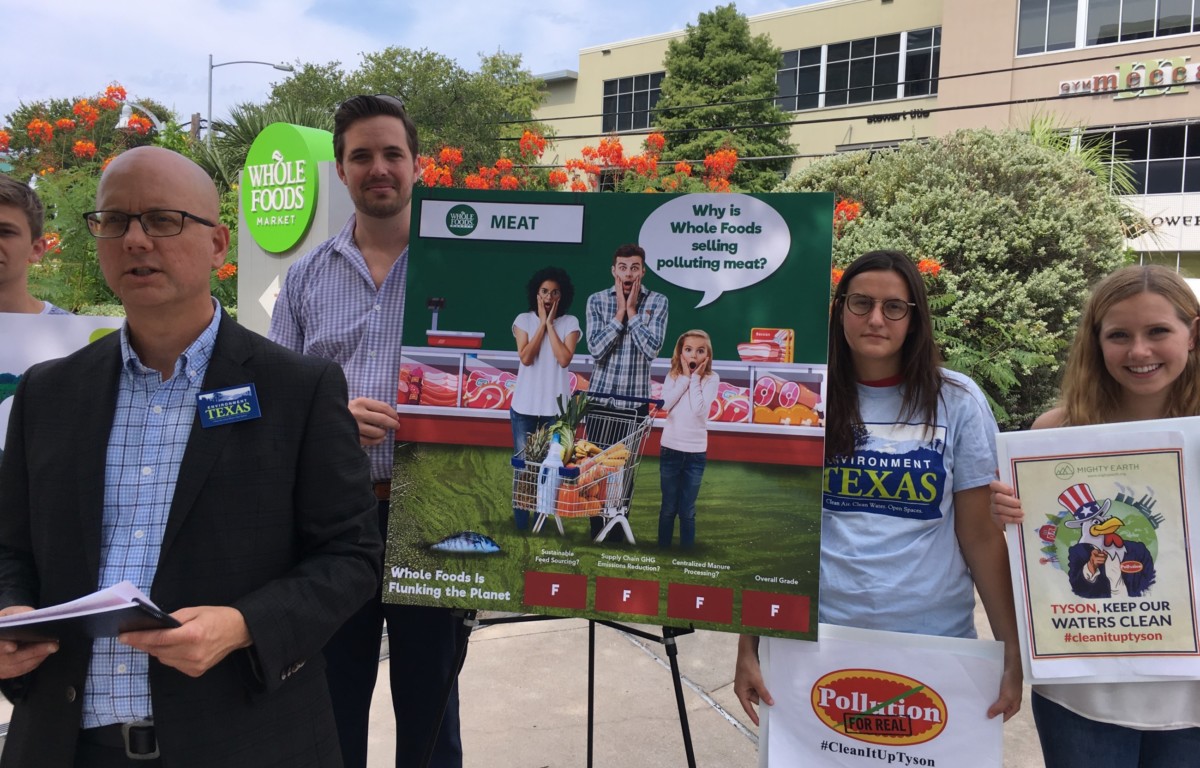Did you know that Truthout is a nonprofit and independently funded by readers like you? If you value what we do, please support our work with a donation.
Whole Foods bills itself as “America’s healthiest grocery store,” but what it’s doing to the environment is anything but healthy. According to a new report, the chain is helping to drive one of the nation’s worst human-made environmental disasters: the dead zone in the Gulf of Mexico.
By not requiring environmental safeguards from its meat suppliers, the world’s largest natural and organic foods supermarket — and most of its big-brand counterparts in the retail food industry, like McDonald’s, Subway and Target — are sourcing and selling meat from some of the worst polluters in agribusiness, including Tyson Foods and Cargill. The animal waste and fertilizer runoff from their industrial farms end up in the Gulf of Mexico, where each summer, a growing marine wasteland spreads for thousands of miles, leaving countless dead wildlife in its oxygen-depleted wake.
“The major meat producers like Tyson and Cargill that have consolidated control over the market have the leverage to dramatically improve the supply chain,” according to the report, which was released by Mighty Earth, an environmental action group based in Washington, DC. “Yet to date they have done little,” the report’s authors note, “ignoring public concerns and allowing the environmentally damaging practices for feeding and raising meat to expand largely unchecked.”

On August 2, the day the report was released, those public concerns found a voice as citizens, environmentalists and sustainability advocates gathered outside Whole Foods headquarters in Austin, Texas, to deliver 95,000 petition signatures demanding that the company hold its meat suppliers accountable for their role in destroying the environment.
“Grocery stores like Walmart and Whole Foods and meal outlets like McDonald’s and Burger King have the power to set and enforce standards requiring better farming practices from suppliers,” states the report, which Mighty Earth says is the “first comprehensive assessment of major US food brands on their environmental standards and performance for sourced meat.”
Feeding the Nation, Failing the Environment
Ranking the largest food companies in the US based on their sustainability policies for meat production, the report found that the biggest players in the food industry — including major fast food, grocery and food service companies — are failing to protect the environment from the impact of their supply chains. Remarkably, the researchers found that not a single one of the 23 major brands surveyed have policies in place to require “even minimal environmental protections from meat suppliers.”
Even more startling is that so-called “green” brands like Whole Foods that have built their reputations on providing sustainable food options have, according to the report, “failed to commit to environmentally responsible farming practices that protect drinking water, prevent agricultural runoff and curb climate emissions.”
The 23 companies surveyed were evaluated on their requirements for meat suppliers regarding where they source their animal feed, how they process their animals’ manure and how they manage their greenhouse gas emissions.
All but one of the companies scored an “F” overall for their environmental policies (or lack thereof) for meat sourcing. The only company to score better than an “F” was Walmart, which received a “D” due to its goal of reducing greenhouse gas emissions across its supply chain, as well as the launching of programs meant to improve the management of manure and increase the sustainability of corn and soy farming.
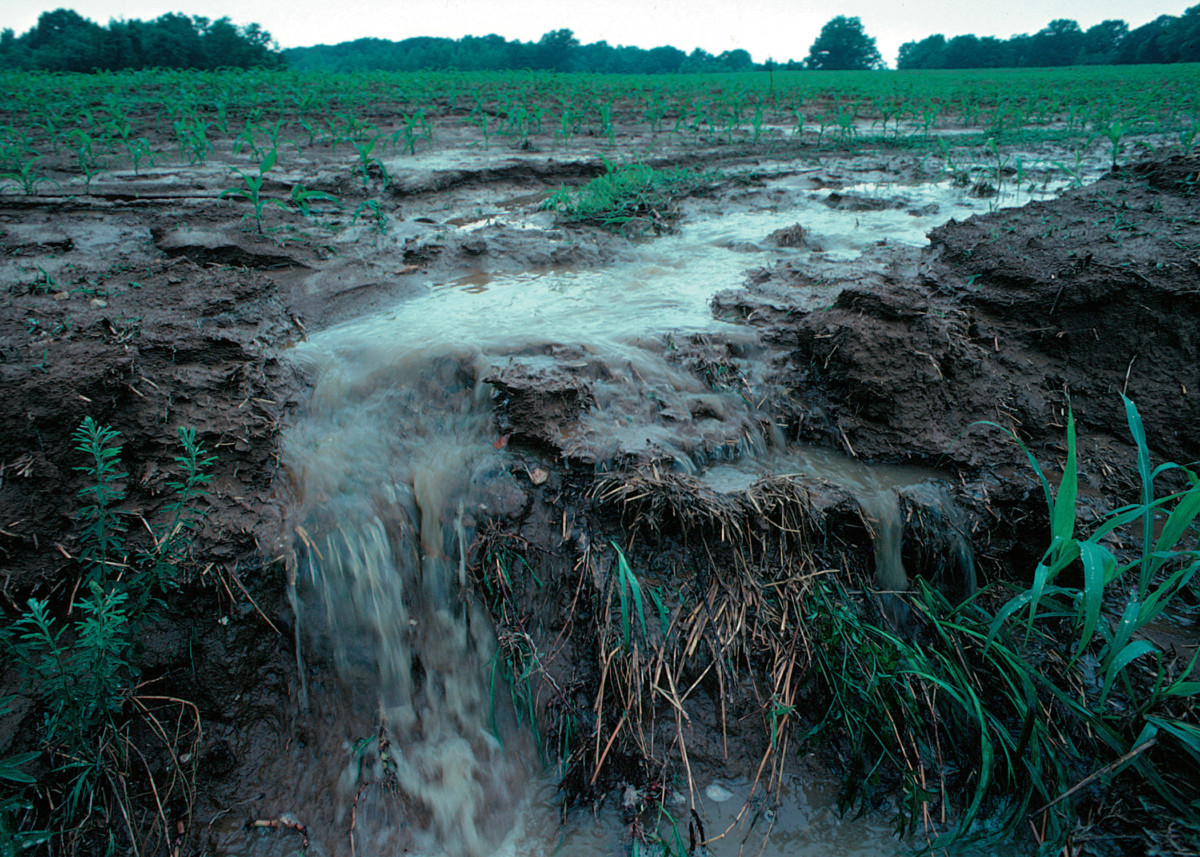
Dead Cows on Your Plate, Dead Fish in the Ocean
In oceans and large lakes across the globe, human activities are creating oxygen-depleted areas where marine life can no longer survive. These hypoxic areas, currently numbering more than 400 around the globe, are commonly known as “dead zones,” and are caused by an increase in certain chemical nutrients like nitrogen and phosphorus that drive the massive growth of algae, causing the spread of deadly “algal blooms.” As the algae decomposes, their biomass consumes the oxygen in the water, suffocating fish and other marine life.
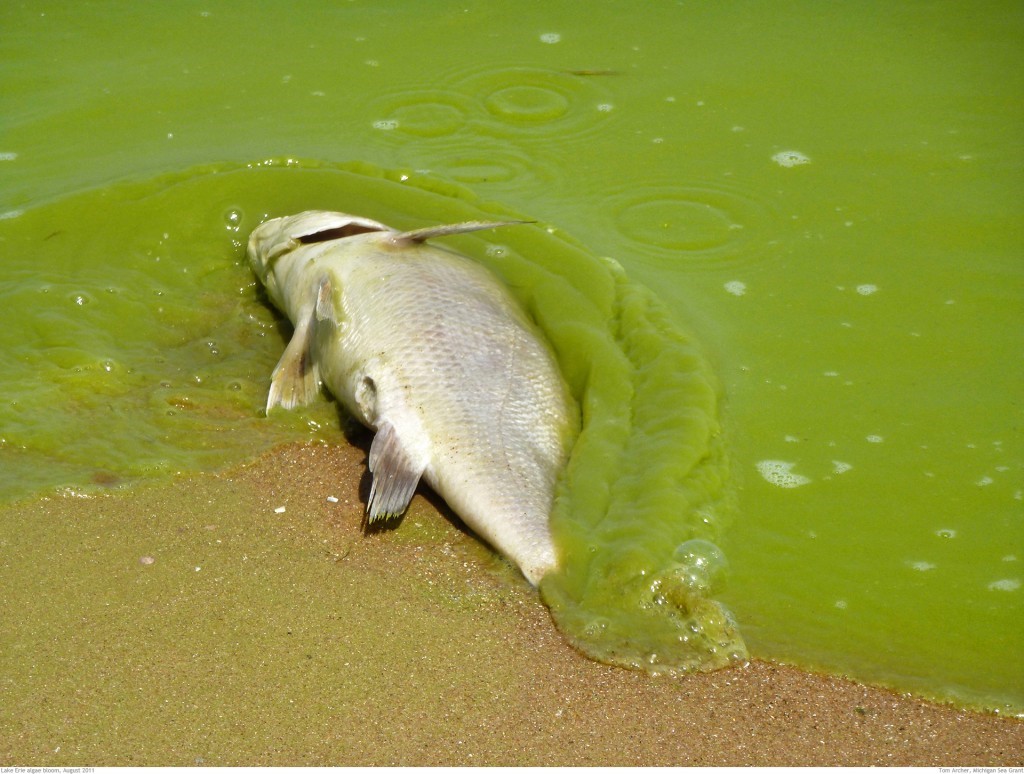
In the United States, the largest recurring dead zone is located in the Gulf of Mexico, mainly off the coast of Louisiana, and extending east to the Mississippi River Delta and west to Texas. The Gulf acts as a massive drainage basin for polluted water containing manure and fertilizer runoff coming from the American heartland, from major beef-producing states like Texas, Oklahoma, Iowa, Kansas and Nebraska. During summer months, this area becomes a 7,000-mile-wide lifeless region — the only reminders of past life being the bodies of fish, crabs, shrimp and other marine animals that have suffocated due to a lack of oxygen. The Gulf of Mexico dead zone is the second-largest human-caused dead zone in the world, after the hypoxic zone in the Gulf of Oman.
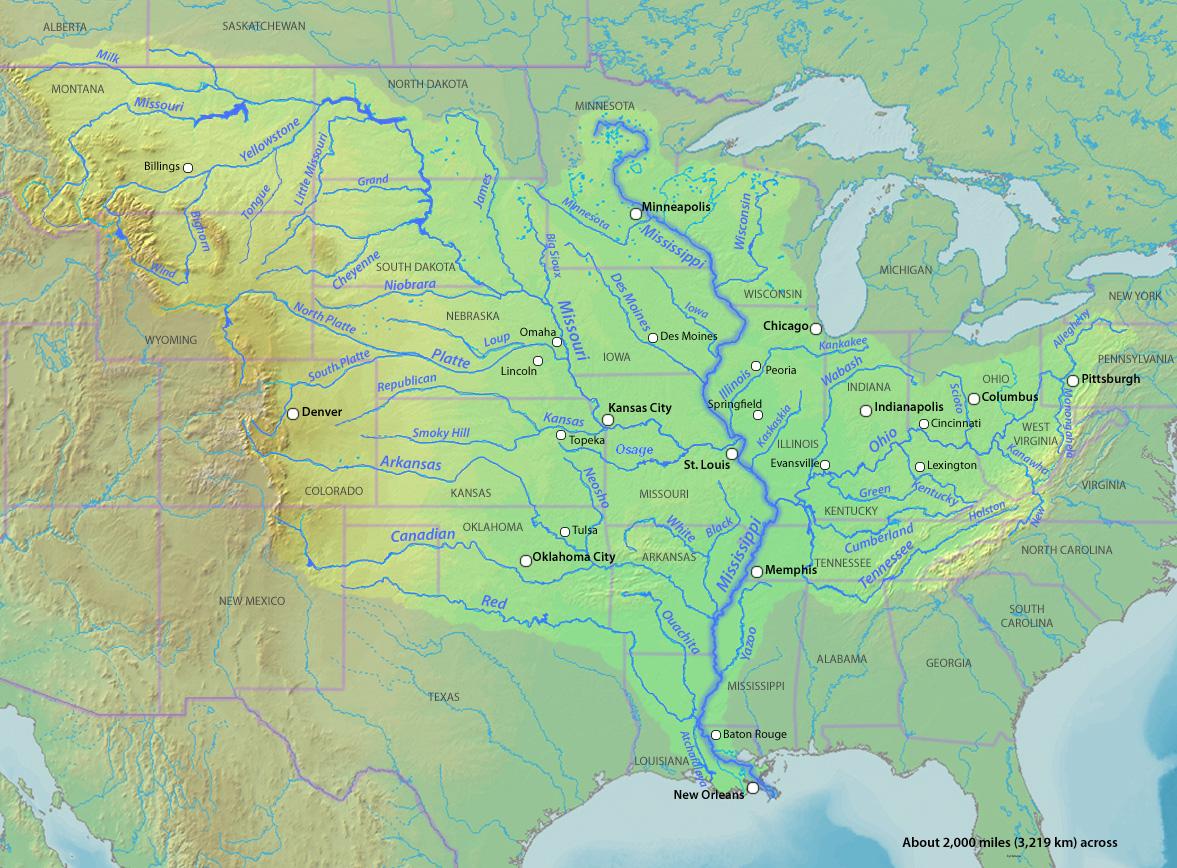
“Excess nutrients bleeding off fertilized crops constitute the overwhelming source—over 70 percent—of the nutrient pollution that causes the Gulf Dead Zone,” Donald Boesch, a professor of marine science and former president of the University of Maryland Center for Environmental Science, told the Independent Media Institute.
In August 2017, scientists measured the Gulf of Mexico dead zone and found that it was at its largest since the mapping of the zone began in 1985 — more than 8,000 square miles. But recently, scientists reported that the area is only about 40 percent of its average size. That doesn’t mean that it is no longer an issue. “Although the area is small this year, we should not think that the low-oxygen problem in the Gulf of Mexico is solved,” Nancy Rabalais, a marine ecologist at Louisiana State University and the lead scientist of the study, told The Associated Press. “We are not close to the goal size for this hypoxic area.”
Nearly half (45 percent) of the Earth’s landmass is being farmed by the global industrial livestock system, which includes both the animals killed for human consumption and the crops used to feed those animals. The current human population, 7.6 billion, is expected to swell to 9.8 billion by the year 2050. And if most of them will be meat-eaters, the negative impact of the meat industry on marine ecosystems and coastal communities, if not addressed soon, will surely get worse. According to NASA, “The number and size of ocean dead zones is closely connected to human population density.” It’s basic math: More people means more meat-eaters, and more meat production means more and bigger dead zones.

More Pathogens, More Pollutants, Less Profit
Dead zones could also introduce a host of public and animal health issues. Boesch points out that “various pathogenic microorganisms can thrive” in hypoxic areas. A 2012 study published in FEMS Microbiology Ecology discovered “sequences affiliated with Clostridium,” a human pathogen that causes botulism and diarrhea, in the hypoxic zone of China’s Lake Taihu. The National Oceanic and Atmospheric Administration (NOAA) warns that algal blooms contain cyanobacteria, “which are poisonous to humans and deadly to livestock and pets.”
Renee Dufault is a former environmental health officer for the National Institutes of Health, the Environmental Protection Agency and the Food and Drug Administration, as well as the founder of the Food Ingredient and Health Research Institute. Dufault told the Independent Media Institute that the antibiotics and hormones injected into animals raised for food “are pollutants themselves when they are released from manure via surface water runoff into streams that may be used as drinking water supplies.”
Dead zones also have economic impacts that harm local communities. The NOAA estimates that marine dead zones cost the US food and tourism industries $82 million every year.
Risky Business: Eating Meat
The main source of water contamination in the United States is the manure and fertilizer coming from industrial farms that grow feed to raise animals to be killed for human consumption.
The production of meat isn’t just one of the most polluting of all human activities, contaminating waterways and driving the growth of dead zones across the world; it’s literally bulldozing the planet’s landscape. By converting rainforests and prairies into industrial farms, large-scale meat producers are responsible for the widespread destruction of many of the planet’s native ecosystems, which threatens wildlife by destroying native habitats and releases stored carbon dioxide into the atmosphere, further exacerbating climate change. Animals raised for food produce 42 percent of agricultural emissions in the US. Two-thirds of those gases are emitted directly by those animals in the form of belches and farts. And the majority of those emissions—around 44 percent—is methane, a greenhouse gas that is 30 times more potent than carbon dioxide.
A report released in July by the Institute for Agriculture and Trade Policy offers some perspective: The top five meat and dairy companies, including Tyson and Cargill, emit more greenhouse gases combined than ExxonMobil, Shell or BP.
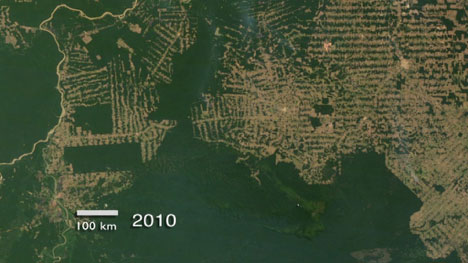
A Few Bright Spots
The Mighty Earth report does note a few positive developments. Of the sectors studied, the food service industry that caters meals to universities and hospitals “is doing the most to promote plant-based diets, with Aramark reporting that 30 percent of its menus offer non-meat options and Sodexo reducing beef consumption through its mushroom-blended burger initiative.” And McDonald’s states that it is moving toward 100 percent sustainably certified soy by 2020 to feed the chickens it sources in Europe. (Unfortunately, that requirement isn’t in place for US suppliers.)
“Bright spots were few and far between,” the report states, “but indicate that awareness is growing and improvements are possible.”
Possible, yes. But probable? The food industry has shown a reluctance to enact sustainable practices, but has sometimes responded to consumer demand for change. “Many of these companies have set requirements for meat suppliers to improve practices around animal welfare and antibiotic overuse when the public pressured them to do so,” Mighty Earth campaign director Lucia von Reusner told the Independent Media Institute. Her organization is hoping that their report will help raise public awareness, and that in turn will spur change within the industry.
“The public is now waking up to the industry’s polluting practices and demanding improvements,” she said.
Reforming the Meat Industry
One of the biggest misperceptions that the general public has about dead zones, says Boesch, is that “there is nothing we can do about them.” He points out that, “although experience in other parts of the world shows that while it may take years for the excess nutrients to wash out of the watershed and [be] purged from bottom sediments, we can eventually breathe life back into dead zones if we reduce nutrient pollution. We are now seeing the dead zone in the Chesapeake gradually becoming less severe and smaller.”
The Mighty Earth report recommends that meat producers start employing better farming practices to help curtail the destruction. One way to reduce the need of fertilizers on crops used to feed livestock, for example, is to use cover crops, which involves planting certain species on fields that can suffocate weeds, control pests and diseases, reduce soil erosion, improve soil health, boost water availability and increase biodiversity — all of which would benefit any farm. Mighty Earth also recommends that meat producers employ better fertilizer management, conserve native vegetation and centralize manure processing.
“The environmental damage caused by the meat industry is driving some of the most urgent threats to the future of our food system — from contaminated waters to depleted soils and a destabilized climate,” von Reusner said. “More sustainable farming practices are urgently needed if we are going to feed a growing population on a planet of finite resources.”
Unfortunately, there is little that the federal government is doing on this front. “Runoff pollution and greenhouse gas emissions from producing meat are largely unregulated in the US,” von Reusner notes. “There need to be much stronger regulations that protect our waters and climate from the meat industry’s pollution.”
Boesch notes that an action plan agreed upon in 2001 by the Mississippi River/Gulf of Mexico Watershed Nutrient Task Force was meant to scale down the amount of nutrient pollution in the Gulf by 30 percent. But, he says the plan “lacks teeth.” Consequently, he said, “not only has the Gulf’s dead zone not shrunk, but the concentrations of polluting nutrients in the Mississippi River have not declined — and may have even increased.”
In the meantime, polluting the Gulf with meat production runoff continues apace. The 2001 federal and state action plan, which was reaffirmed and amended in 2008, hasn’t achieved its goal to reduce the hypoxia in the Gulf of Mexico. NOAA scientists have forecasted this summer’s dead zone to be “similar to the 33-year average Gulf dead zone of 5,460 square miles,” which the agency points out is about the size of Connecticut. “This should be getting more attention by regulators, lawmakers and industry,” said Boesch. “Unfortunately, the industry has worked with politicians to prevent regulations.”
He notes that the plan to revive the Chesapeake Bay has each state “allocated a certain amount of reduction in nutrient pollution and is under a legally binding agreement under the Clean Water Act to accomplish this by 2025.” But there is no such legal force when it comes to the Mississippi Basin states that are polluting the Gulf. Those states, says Boesch, “have never even been assigned an amount of pollution reduction for which they are responsible, much less been bound to it. The states have resisted even this first step in accepting responsibility. All efforts are strictly voluntary. So, there can be little wonder why, despite the commitment to reduce the size of the dead zone by two-thirds, there has been virtually no reduction in polluting nutrients discharged by the river after 17 years.”
While reforming the meat industry’s unsustainable practices is a way to stop the spread of dead zones, change from within isn’t coming quickly enough. That’s where consumers can play a vital role, says von Reusner. “Consumers need to demand that their favorite food companies provide more sustainable options by requiring more sustainable farming practices from meat suppliers.”
This article was produced by Earth | Food | Life, a project of the Independent Media Institute.
Media that fights fascism
Truthout is funded almost entirely by readers — that’s why we can speak truth to power and cut against the mainstream narrative. But independent journalists at Truthout face mounting political repression under Trump.
We rely on your support to survive McCarthyist censorship. Please make a tax-deductible one-time or monthly donation.
